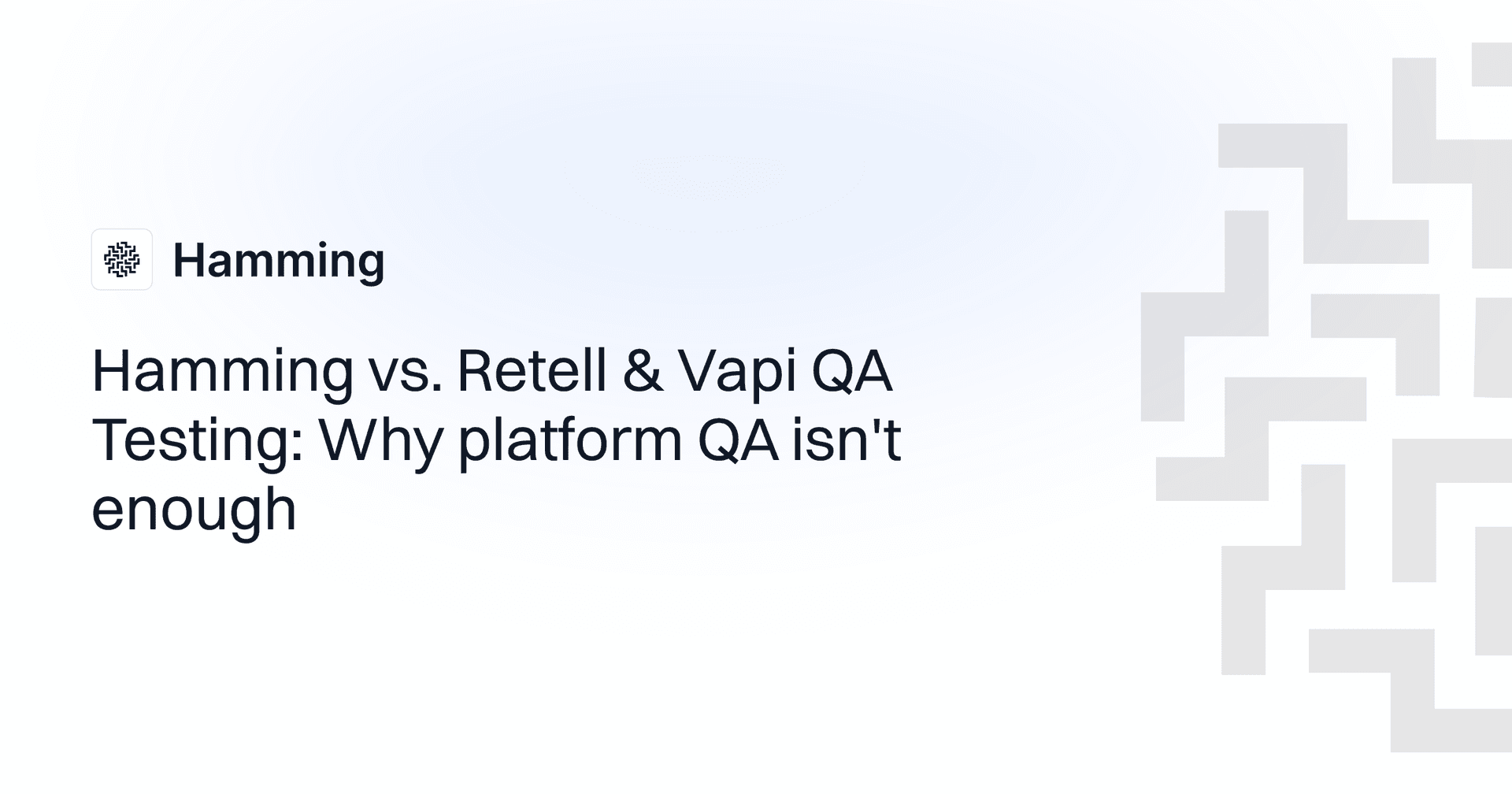Beyond the Script: How Hamming outtests Retell and Vapi's built-in QA
Demo agent with predictable flows? Clean audio? Retell's and Vapi's built-in testing will cover you. This comparison is for production deployments—real users with accents, background noise, and the kind of unpredictable behavior that scripted scenarios don't prepare you for.
Quick filter: If you’ve ever had “100% passing” tests and a broken launch, you already know why scripted QA isn’t enough.
100% test coverage used to mean "ready to ship" in my mind. Then I started watching agents pass every scripted test and fail in production anyway. Real callers don't follow scripts. They interrupt. They mumble. They change their minds mid-sentence. Scripted testing validates what you expect. Stress testing reveals what you missed.
A dashboard full of green checkmarks can be the most dangerous thing in your QA process. We've started calling it the "green checkmark illusion"—false confidence about production readiness based on tests that only cover what you planned for. The tests pass because they test what you planned for. Production fails because users do what you didn't plan for.
- Retell and Vapi validate scripted flows: Good for CI, weak against real-world chaos.
- Hamming simulates noisy, unpredictable user behavior, including accents, interruptions, emotions, and drift.
- Result: Hamming identifies failure modes before users encounter them and converts them into new tests.
Your tests are usually 100% ready till they meet the real world
The team tests all the expected flows. Balance checks, money transfers, and transaction cancellations. QA signs off. We're confident it's ready.
Then it hits prod.
And real users start calling with noise, hesitation, weird phrasing, and all the things the test never saw.
Someone asks for their balance while driving through a tunnel. Another caller has a thick regional accent. A third changes their mind halfway through a transfer.
Suddenly, the agent is misfiring. It transfers funds without confirmation. It escalates basic calls. It hallucinates, and now there's a compliance ticket in someone's inbox.
The QA team insists: "It was 100% tested." And they're right, but for the flows they remembered to script.
Dedicated QA vs Creator Platforms: Feature Comparison for Voice Agent Testing
| Dimension | Vapi/Retell | Hamming |
|---|---|---|
| Test scope | Validates predefined, scripted flows | Simulates unpredictable, real-world call behavior |
| Test volume | Dozens of manual test cases per suite | Thousands of concurrent synthetic calls per run |
| Audio realism | Clean, ideal voice input | Injects accents, background noise, latency, and jitter |
| Behavior modeling | Deterministic inputs, fixed paths | Dynamic personas with mid-turn changes, interruptions |
| Failure detection | Pass/fail based on expected transcript | Flags hallucinations, latency, scope drift, and missed intents using LLM-based scoring |
| Regression coverage | Static, depends on what you manually script | Expands over time, flagged production calls become new tests automatically |
| Production visibility | None, designed for pre-deployment testing only | Scores every live call post-launch for quality and compliance drift |
| Compliance reporting | Manual transcript exports | Automated, audit-ready compliance summaries |
| Best use case | Fast regression checks on known flows | Pre-launch stress testing + post-launch monitoring at scale |
What's the difference between Creator Platform Testing and Hamming?
1. Test Model: Deterministic vs. Adversarial
Vapi and Retell's built-in testing is like a voice-enabled unit test. You write the prompt, tell it what to expect, and it checks if the agent responds as planned. It's quick and reliable, but only for the cases you thought to cover.
Hamming builds hundreds of synthetic callers per scenario, introducing variability to surface edge cases before they hit production.
2. Audio Simulation: Limited Denoising vs. Full Chaos
Vapi and Retell offer optional denoising via Krisp or Fourier-based filters, but require fine-tuning. It doesn't simulate packet loss, encoding glitches, or channel distortion.
Hamming injects real-world audio variance, noise, jitter, and accents across thousands of concurrent streams.
3. Behavioral Coverage: Static Expectations vs. Dynamic Personas
Vapi and Retell support turn-taking, interruption detection, and endpoint tuning in clean pipelines, but every path must be explicitly scripted.
4. Failure Detection: Transcript Match vs. LLM-Driven Scoring
Vapi and Retell rely on exact transcript matches and edge-heuristic checks.
Hamming leverages LLM-based judges to score each call for hallucinations, latency issues, misrouted intents, and compliance drift on all live calls.
5. Test Suite Evolution: Manual vs. Automated
Vapi and Retell require engineers to manually write new tests as use cases expand.
Hamming auto-generates regression tests from flagged production calls, building a "golden dataset" that improves over time.
Summary
-
Retell and Vapi excel at routine regression on known user flows under ideal conditions.
-
Hamming surfaces issues in noisy, chaotic real-world usage before they impact customers.
For teams managing compliance, latency SLAs, multilingual support, and complex conversational logic, you need both coverage layers. Creator Platforms ensures the basics don't break, and Hamming ensures your agent holds up when things go off-script.
Unit tests from creator platforms don't prep you for production.
Tools like Vapi and Retell offer quick validation for voice agents, but they're fundamentally unit tests wrapped in a UI. You define the prompt, you define the expected response, and the system checks if they match.
That's useful. But only up to a point.
These tests don't account for what happens when users speak over each other, restart mid-turn, or talk through packet loss. They don't inject edge cases. They don't explore behavior drift.
They just verify that the bot follows instructions in a clean room.
And that's the problem: production isn't clean. And that's where it fails you.
Scripted Tests Are the First Line of Defense, Not the Last
Vapi and Retell aren't the problem. They're the equivalent of unit tests. You need them. They check if your happy paths still run, if the latest change didn't break something obvious. Fast to run. Easy to plug into CI and ensure basic hygiene.
But that's all they are.
They don't prepare your voice agent for the real world. They won't catch the caller who changes their mind halfway through a sentence. Or the one speaking over road noise. Or the one who mixes Hindi and English in the same breath.
That's what Hamming is built for. Think of it as your end-to-end test suite, but for voice. It simulates messy humans at scale, noise, interruptions, latency, code-switching, and tracks how the agent handles drift, delay, or straight-up hallucination.
Creator Platforms checks if the happy path still works. Hamming checks if your agent still makes sense when users don't.
When to use Vapi or Retell, when to use Hamming, or both
-
Vapi and Retell are solid for checking if the happy path still holds once you've finished building. It makes sure the core flows do what they're supposed to. But it doesn't tell you what happens when users do something you didn't plan for.
-
Hamming is built to catch what you didn't plan for. It stress-tests the full system with real-world noise, off-script behavior, and unpredictable callers.
-
For any production-grade agent, especially in regulated or sensitive use cases, you'll need both: tight scripted checks and broader behavioral coverage.
Hamming doesn't just test the script. It tests the system.
Here's the reality engineers need to know:
-
Accent coverage is weak. One report found 66% of users encountered failures because their accent or dialect wasn't recognized, a huge blind spot for scripted tests.
-
Noise cuts accuracy. Research shows that adding real-world background noise to training data reduces speech recognition word error rates by about 25%.
-
Dysfluencies matter. ASR systems underperform with non-standard speech like stuttering or hesitation, error rates jump by around 14%, even on high-quality agents.
That's the kind of variability Vapi and Retell don't test for.
With Hamming's real-world stress testing, every caller branches, retries, and adapts.
Every call is scored in real time by LLM judges watching for hallucinations, off-topic replies, slow response times, and compliance drift.
And when something breaks?
That call gets added to your Hamming test suite automatically. Over time, your regression tests stop being guesswork. They start reflecting the real-world edge cases your agent encounters. The test suite evolves with production.
This is how you make sure it holds up in production.
What This Means for Your Team
-
Vapi and Retell are powerful for validating known flows, but do not scale to unknowns.
-
Hamming is designed to uncover and guard against unanticipated behaviors at scale.
-
For robust voice agent delivery, especially in regulated, mission-critical domains, you need both scripted validation and systemic stress and observability testing.
Green checks don't mean go. Run a Hamming test before your next deployment.
Flaws but Not Dealbreakers
This comparison has inherent bias. Worth knowing upfront:
Hamming is one of the platforms being compared. We've tried to be fair about what Retell and Vapi do well, but you should verify our characterizations with those vendors directly.
Scripted testing isn't bad. Retell's and Vapi's built-in testing catches configuration errors, flow breaks, and obvious regressions quickly. Don't replace it with stress testing—layer stress testing on top of it.
Stress testing is slower and more expensive. Running thousands of synthetic calls takes longer and costs more than scripted validation. Most teams run comprehensive stress tests pre-release, not on every commit.
There's a tension between coverage and cost. You can test more scenarios or test them more deeply. Different teams make different tradeoffs based on risk tolerance and deployment frequency.

